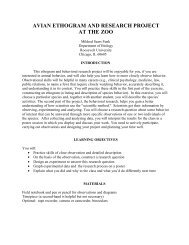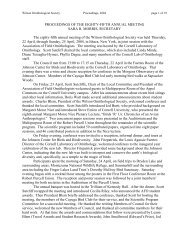Available now - Wilson Ornithological Society
Available now - Wilson Ornithological Society
Available now - Wilson Ornithological Society
You also want an ePaper? Increase the reach of your titles
YUMPU automatically turns print PDFs into web optimized ePapers that Google loves.
WOS 2010 ~ ABSTRACTS p. 30<br />
is needed to determine whether these data indicate that the yellow component of the plumage may be a stronger<br />
selecting factor than the ultraviolet.<br />
P11 S Early successional habitat characteristics and fruit abundance influence stopover use of fall migrating<br />
songbirds. Brad Mudrzynski and Christopher Norment, Dept. Environmental Science and Biology, SUNY College<br />
at Brockport, Brockport, NY 14420<br />
During the 2008 and 2009 fall migrations we used mist nets and visual transects to examine bird use of shrublands<br />
and early successional forests at Iroquois National Wildlife Refuge, NY. The relationship between mist net captures<br />
and transect detections varied across species and habitats, with significant positive relationships for Gray Catbirds<br />
(Dumetella carolinensis) (R2=0.668) and Song Sparrows (Melospiza melodia) (R2=0.384) in shrublands. There<br />
were no significant relationships between the two measures of abundance in forest habitat, or for smaller species<br />
such as warblers in shrublands. Bird abundance was generally greater in shrublands than in early successional<br />
forests and we counted more species using the shrublands, 16, than forest habitat, 9. American Robin (Turdus<br />
migratorius) abundance was positively correlated with shrub cover (p=0.042) and honeysuckle fruit abundance<br />
(p=0.000), while Song Sparrows preferred fields with more red panicled dogwood fruit (p=0.008) and greater<br />
fruiting shrub species richness (p=0.002). These results indicate that in general migrating songbirds prefer<br />
shrublands to early successional forests for stopover habitat; however, exact habitat preferences differ among<br />
species.<br />
P12 An assessment of refueling rates and diet of songbirds during migratory stopover at the Braddock Bay Bird<br />
Observatory. Susan B. Smith, Dept. Biology, Villanova Univ., Villanova, PA 19085<br />
Migrating songbirds rely on stopover sites to rest and replenish body fat and protein but must overcome the<br />
challenges of acquiring food in unfamiliar habitats in order to efficiently refuel before continuing migration. Thus,<br />
the rate at which these birds can replenish energy stores is affected by food availability and quality. I compared<br />
refueling rates and nutritional state of birds captured during spring and fall migration in 2009 at the Braddock Bay<br />
Bird Observatory, an important migratory stopover site on the south shore of Lake Ontario. I measured plasma<br />
concentrations of triglyceride, an indicator of fat deposition, and uric acid, an indicator or dietary protein intake, in<br />
several seasonally frugivorous species that are commonly captured at this site. There were no interspecific<br />
differences in plasma metabolite concentrations during spring; however, during fall Swainson’s Thrushes had<br />
significantly higher plasma triglyceride than White-throated Sparrows and significantly lower plasma uric acid than<br />
White-throated Sparrows and Red-eyed Vireos. I addition, plasma triglyceride was significantly higher and plasma<br />
uric acid was significantly lower during fall compared to spring in Swainson’s Thrushes. Seasonal differences in<br />
triglyceride, but not uric acid, were present in Red-eyed Vireos. These results suggest that there are differences in<br />
dietary protein intake between seasons for some species, most likely representing a switch to frugivory in the fall,<br />
and many birds are able to refuel at a higher rate during fall, possibly due to their consumption of abundant fruit<br />
resources.<br />
P13 Remote radar monitoring of bird activity via the network. Robert C. Beason, Accipiter Radar Corporation,<br />
Orchard Park, NY 14127<br />
Radar is being used increasingly to monitor and record migration and local movements of birds for basic research<br />
and environmental monitoring. Although analog avian radar systems require the presence of an operator to collect<br />
and record data, digital radar systems do not. Digital data can be collected with the radar operating unattended then<br />
reviewed (played back) at the researcher’s convenience. In order to observe activity such as nocturnal migration in<br />
real time, an observer must usually monitor the display directly. Although the raw radar video can be sent to a<br />
remote location through a network, it requires high bandwidth, which is difficult to achieve at remote field locations.<br />
We present a technique to remotely monitor radar detections and tracks of birds in real time. The underlying<br />
mechanism is to reduce the raw radar signals to metadata (i.e., detection and track data) before transmitting them<br />
across the network. Using a radar data server, multiple researchers can simultaneously monitor bird activity from the<br />
same radar, each at a different remote location and each with a display customized to his or her needs. During the<br />
meeting I will demonstrate this capability of real-time monitoring of nocturnal migration by connecting to a radar<br />
located on the highest point of the Niagara escarpment near Fonthill, Ontario, 200 km west of Geneva, NY. This<br />
location provides coverage of the eastern end of Lake Erie and the western end of Lake Ontario. Recorded data from<br />
previous nights’ migration will also be presented.<br />
P14 Annual variation in arrival of long-distant migrants and a comparison of first capture dates and condition<br />
between verified breeders and presumed migrants. Margret I. Hatch, Penn State Worthington Scranton, Dunmore,<br />
PA 18512 and Robert J. Smith, Dept. Biology, Univ. Scranton, Scranton, PA 18510<br />
As part of an on-going study of the ecology of migration at our field site in Northeastern Pennsylvania we examined<br />
annual variation in arrival of six long-distance migrant species that breed at our site. We also examined whether





